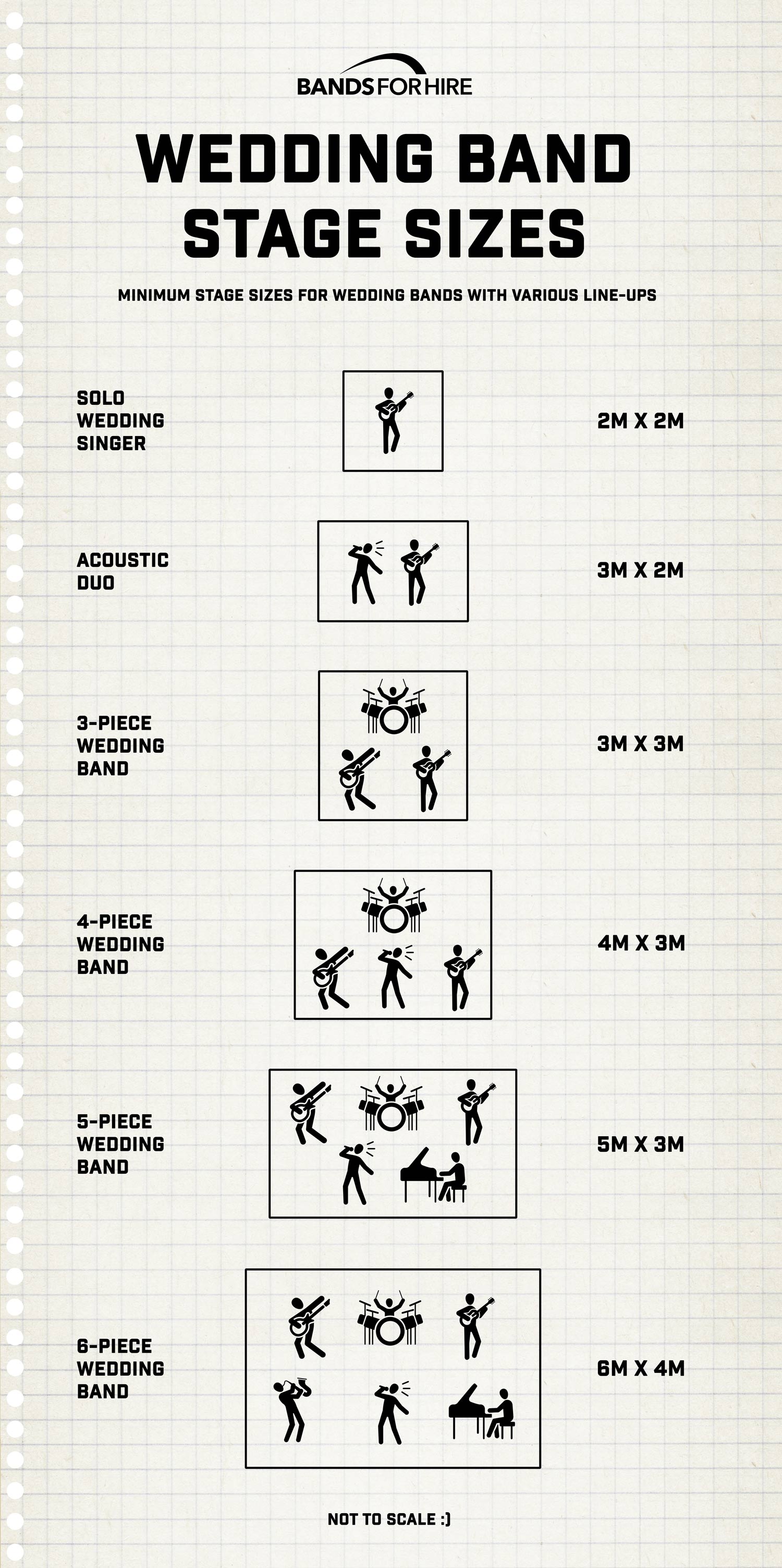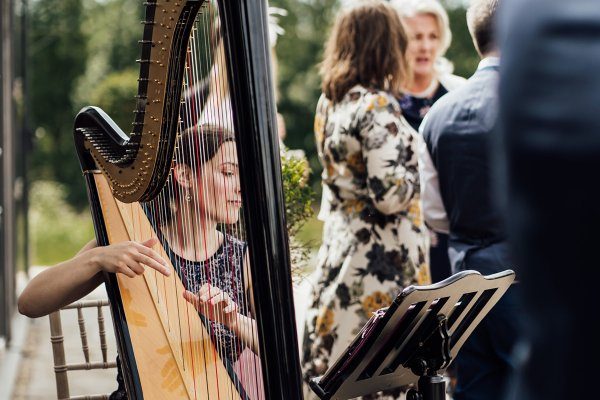Setting Up the Wedding Band: Stage Sizes and Performance Space
- blog
- Updated: 21st March 2025
Getting the stage size right for your wedding band is key to a seamless performance and visually striking setup. The infographic below shows approximate stage sizes for different band configurations - take a look before we move on to the details.

Does a wedding band need a stage?
Before we look into the specifics of stage sizes and performance spaces, let's address a common question many couples have when booking a wedding band: "Do we even need a stage?"
With the extra expense hiring a stage brings, many of you will be relieved to hear that a stage isn't necessary for most wedding bands. From my experience as a musician, I can attest that a stage was provided at less than half of the weddings I played over the course of a decade.
That being said, it's essential to consider the specific needs and preferences of your venue and wedding band when deciding whether or not to have a stage. Afterall, a stage will undoubtedly add an extra level of professionalism and enhance the overall live experience for you and your guests.
Performance Space
Whether or not you decide to use a stage, it's essential to ensure there's adequate performance space set aside for the band. Having ample space will ensure the band can easily move around and interact with the audience for a far more engaging performance.
Every band has their own unique requirements when it comes to performance space, and it's important to take these into account when planning. Factors such as the number of band members, the type of music they play, and the equipment they use, all play a role in determining the appropriate performance space. For example, if you've booked a large wedding band featuring multiple vocalists, horn section and choreography, they'll likely need far more space than a small acoustic band.
How much space does a wedding band need?
Below we've outlined some minimum stage dimensions to get you started. If you're working with a spacious venue, increasing the performance area is always advised to get the most out of the band's performance.
Solo musician: 2 x 1.5 metres
A solo act or instrumentalist can generally fit into most spaces. Solo wedding singers often provide a small PA with a raised speaker either side.
Duo : 2.5 x 1.5 metres
If you're booking a jazz act or acoustic duo, they'll need slightly more width for their instruments, but otherwise, a similar depth is required.
Acoustic Trio: 3 x 2 metres
A trio featuring a vocalist, guitarist and percussionist is quite flexible and can adjust the setup to suit most spaces.
3-piece Band: 3 x 2.5 metres
Adding an acoustic drum kit to the mix means the band will need a bit more space to work with. A 3 x 2.5 metre space allows the drummer to set up in the centre with the guitarist and bass player on either side.
4-piece Band: 4 x 3 metres
The definitive 4-piece wedding band featuring vocals, guitar, bass and drums - possibly even keys. The vocalist will usually be placed directly in front of the drum kit, meaning a depth of 3 metres is highly recommended.
5-piece Band: 5 x 3 metres
A typical 5-piece band usually includes vocals, guitar, bass, drums and additional instruments such as keyboard or sax.
6-piece Band: 6 x 4 metres
As the band line-up increases, it's important to note that there may be more variation in space requirements based on the specific line-up and equipment of the band. Each band may have unique requirements and preferences, so it's essential to communicate with them before the day and understand their specific needs.
7-piece band +: 7 x 4 metres
We generally recommend 4 metres depth and an extra metre width for each additional band member.
Sound Engineer Desk
It's also worth keeping in mind that many high-end party bands work with a sound engineer, who may need to set up their mixing desk at the back or side of the room. One square metre should suffice here, but for safety reasons, avoid placing them too close to the dance floor area.
Typcial Modular Stage Sizes
The dimensions mentioned above are fine to use as your stage dimensions, although you may need to round up to the nearest metre. Modern modular stages typically come in 1 x 1 metre sections, allowing for size and configuration flexibility.
Old-style stages, commonly used for marquee weddings, come in 8 x 4 ft (2.42m x 1.21m) blocks, so you'll need to speak to your band to decide which format suits them best.
One last thing to note is that your band can also set their PA speakers up either side of the stage, leaving them more performance space on the stage itself.
Browse our impressive range of wedding bands based across the UK.
Why Use a Stage?
A stage can add a special touch to your wedding and make the band's performance more memorable for you and your guests. Here are four reasons why using a stage will enhance your wedding reception:
- Performing on a raised platform will make the band more visible and create a sense of separation between them and the audience, making the performance feel more special and memorable for guests.
- A stage can create a focal point for the reception, making the band the centre of attention and drawing guests to the dance floor.
- A stage allows the band to move around freely and interact with the audience, making the performance more engaging and interactive.
- Using a stage can add an extra level of professionalism to your wedding, making it look more polished and sophisticated.
Tip for Marquee Weddings!
Wedding marquees and tipis usually have sloping sides, which you'll need to consider when working out dimensions. The easiest solution is to bring the stage forward slightly so the musicians don't hit their heads on the top of the marquee!
Power Supply
When discussing performance space, we mustn't forget to include a section about power requirements.
Most wedding bands need at least two or three standard 13amp household sockets in the performance area and then use their own extension cables as required.
If you're having your wedding reception outside or in a marquee, there are two options available:
Run extension cables from a nearby building:
You'll need to run two separate extensions from at least two 13amp sockets. Remember not to run all your power from one 13 amp socket, as this will blow a fuse. It's also important to ensure the cables are properly rated for outdoor use and protected from damage.
Hire a Generator:
Generators in the UK usually have 16amp sockets, so you'll need to run at least one of these to the stage area and then use a suitable 16amp to 13amp adapter for the band to plug into. This will give them just over 3.5kw*, which is plenty for most wedding bands. Always check exactly how much power your band will need to draw.
*These calculations will differ if working with 120v mains in the USA.
Conclusion
It's essential to ensure that the band has everything they need to perform at their best, including the right stage size, performance space, and power supply. Consider your wedding band's specific needs, and if in doubt, too much space is always better than too little. As they say, it's better to have it and not need it, than to need it and not have it.
Ready to book your wedding band? Head over to our wedding band section to see our exclusive roster of bands in action.






